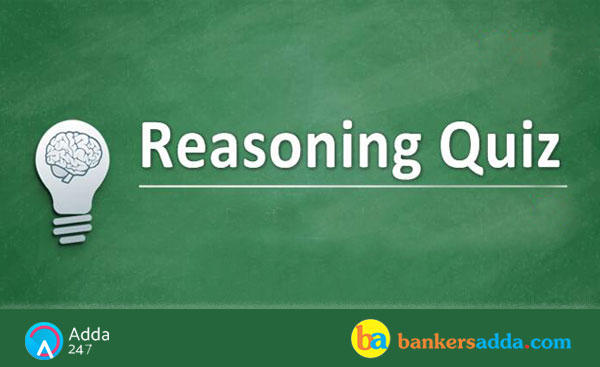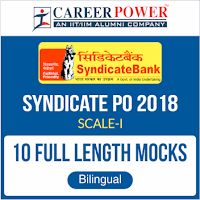Dear Aspirants,
Reasoning Ability is an onerous section. With the increasing complexity of questions, it becomes hard for one to give it the cold shoulder. The only way to make the grade in this particular section in the forthcoming banking exams is to practice continuously with all your heart and soul. And, to let you practice with the best of the latest pattern questions, here is the Adda247 Night Reasoning Quiz based on the exact same pattern of questions that are being asked in the exams.
Directions (1-5): Study the following information carefully and answer the questions given below:
There are eight persons P, Q, R, S, T, U, V and W are sitting around a circular table. Some of them are facing towards the center of table and some of them facing opposite to center of table. All of them have different age viz. 18 yr, 19yr, 20 yr, 21 yr, 22 yr, 23 yr, 24 yr and 25 yr but not necessarily in the same order.
S sits second to right of T, whose age is a prime number. Three persons sit between S and Q, whose age is a perfect square. W sits second to the left of Q. The one whose age is 24 yr sits second to the right of W. P sits third to right of the one whose age is 24 yr. P does not sit adjacent to W. S sits immediate left of one whose age is 22 yr. Three persons sit between one whose age is 22 yr and V. Immediate neighbours of S face opposite direction ( Opposite direction means if one neighbour faces towards the center then other neighbour faces opposite to center of table). Ages of Immediate neighbours of W is not a prime number. W’s age is not a prime number. The one whose age is 18 yr sits second to the left of U, who faces opposite to center of the table. Immediate neighbours of W face same direction ( Same direction means if one neighbour faces towards the center then other neighbour also faces towards the center of table). Immediate neighbours of T face opposite direction ( Opposite direction means if one neighbour faces towards the center then other neighbour faces opposite to center of table). Three persons sit between the one whose age is 20 yr and the one whose age is prime number. The one whose age is 21 yr sits second to the left of the one whose age is 19 yr.
Q1.Who among the following sits immediate left of V
(a) R
(b) W
(c) T
(d) Q
(e) U
Q2. Who among the following sits opposite to S?
(a) R
(b) W
(c) T
(d) Q
(e) U
Q3. Who among the following has 19 yr age?
(a) P
(b) W
(c) T
(d) Q
(e) R
Q4. Four of the following five are alike in a certain way and hence they form a group. Which one of the following does not belong to that group?
(a) S
(b) V
(c) Q
(d) P
(e) T
Q5. Who among the following has 18 yr age?
(a) S
(b) V
(c) Q
(d) P
(e) R
Directions (6-8): Study the following information and answer the questions given below:
(i) ‘P ÷ Q’ means ‘P is sister of Q’.
(ii) ‘P × Q’ means ‘P is brother of Q’.
(iii) ‘P – Q’ means ‘P is mother of Q’.
(iv) ‘P + Q’ means ‘P is father of Q’.
Q6. Which of the following means ‘K is grand mother of V?
(a) M ÷ K + T× V
(b) M × K + T-V
(c) M × K – T +V
(d) M ÷ K – T ÷ V
(e) None of these
Q7. Which of the following means ‘ T is grandson of H’?
(a) H + J + T-V
(b) T × K + H+V
(c) H + J × T÷ V
(d) H – J + T× V
(e) None of these
Q8. If F+J÷T× R-L+V , then which of the following is definitely true?
(a) V is grandson of T
(b) T is daughter of F
(c) R is father of L
(d) R is sister of J
(e) V is grand daughter of T
Directions (9-11): In making decisions about important questions, it is desirable to be able to distinguish between strong arguments and weak arguments in so far as they relate to the question. Strong arguments are those which are both important and directly related to the question. Weak arguments are those which are of minor importance and also may not be directly related to the question or may be related to a trivial aspect of the question.Each question below is followed by two arguments numbered I and II. You have to decide which of the arguments is a strong argument and which is a weak argument.
Give answer
(a) if only argument I is strong
(b) if only argument II is strong
(c) If either I or II is strong
(d) If neither I nor II is strong
(e) If both I and II are strong
Q9. Statements should the public sector undertakings be allowed to adopt hire-and-fire policy?
Arguments
I. Yes. This will help the public sector undertakings to get rid of non-performing employees and will also help to reward the performing employees.
II. No, the management may not be able to implement the policy in an unbiased manner and the employees will suffer due to the high-handedness of the management.
Q10. Statement Should one close relative of a retiring government employee be given a job in government in India?
Argument
I. Yes, where else will the relative get a job like this?
II. No, it will close doors of government service to competent and needy youth.
Q11. Statement Should the term of the elected members of parliament be reduced to two years in India?
Arguments
I. Yes, even otherwise the election are generally held every alternate year in India
II. No, every round of parliament election needs huge amount of money and it’s a national waste.
Directions (12-15): Question consists of five statements followed by five conclusions. Consider the given statements to be true even if they seem to be at variance with commonly known facts. Read all the conclusions and then decide which of the given conclusions does not logically follow from the given statements using all statements together.
Q12. Statements: All book are copy. Some copy are kite. No kite are hour. Some hour are time. All time are month.
Conclusions:
(a) Some month are hour.
(b) All book being kite is a possibility.
(c) Some copy is not hour.
(d) All copy being book is a possibility
(e) All book being copy is a possibiity.
Q13. Statements: Some fly are high. No high is world. All world is large. Some large is Note. All note is pen.
Conclusions:
(a) All large being world is a possibility.
(b) All pen being world is a possibility.
(c) All note being world is a possibility.
(d) All world being large is a possibility.
(e) All fly being note is a possibility.
Q14. Statements: Some mobile is network. Some network is word. Some word is file. Some file is tax. All tax are joy.
Conclusions:
(a) All mobile being word is possibility.
(b) All word being tax is a possibility.
(c) All joy being tax is a possibility.
(d) Some network being joy is a posibility.
(e) All tax being joy is a possibility.
Q15. Statements: All apple are box. No apple is cat. Some cat is kite. All kite is dog. Some dog are camel.
Conclusions:
(a). Some cat is dog.
(b) All cat being dog is a possibility.
(c) Some cat is camel.
(d) All cat being camel is a possibility.
(e) All box being camel is a possbility.




 Reasoning Quiz For Bank Foundation 2024 ...
Reasoning Quiz For Bank Foundation 2024 ...
 Reasoning Quiz For Bank Foundation 2024 ...
Reasoning Quiz For Bank Foundation 2024 ...



